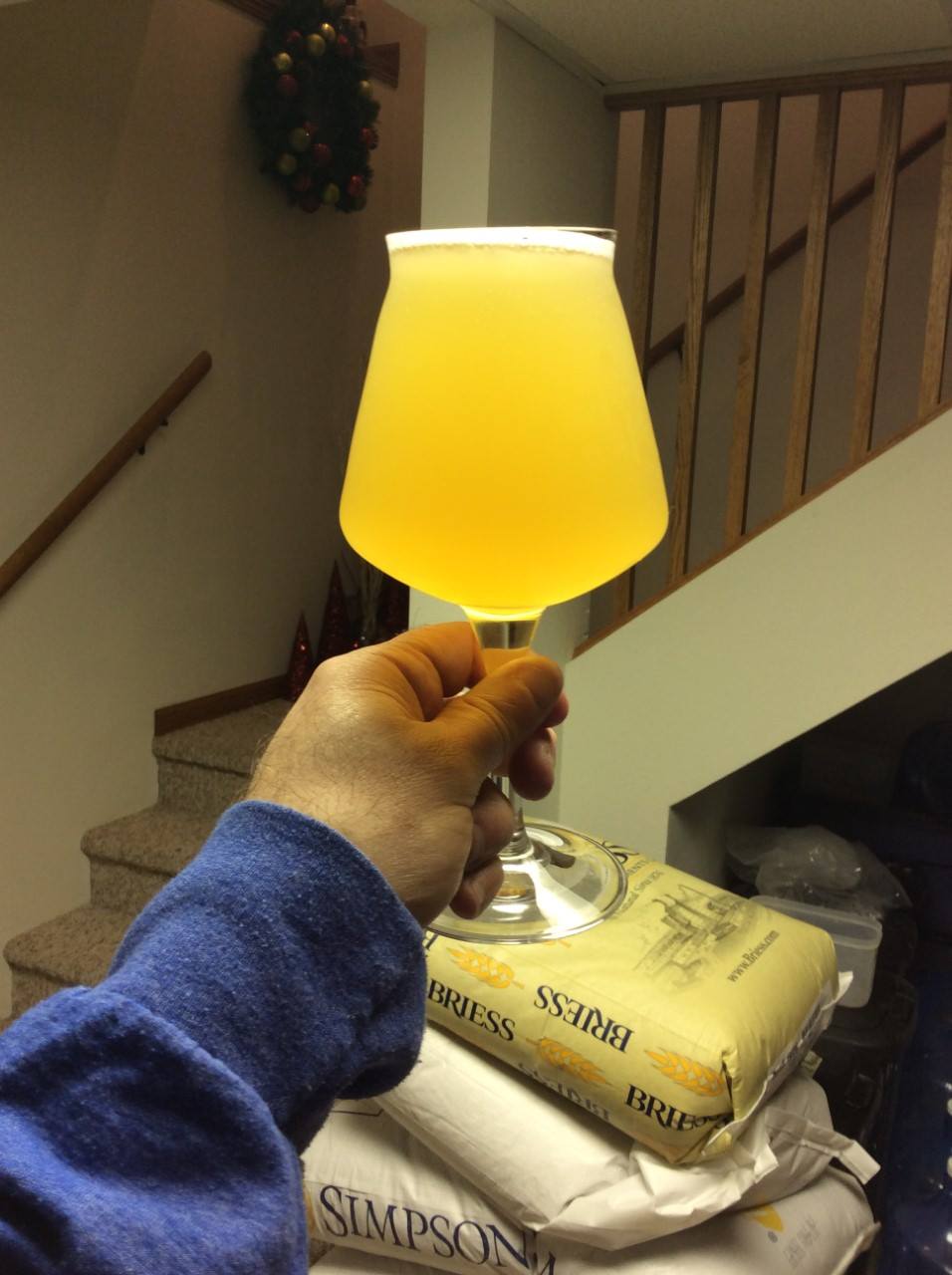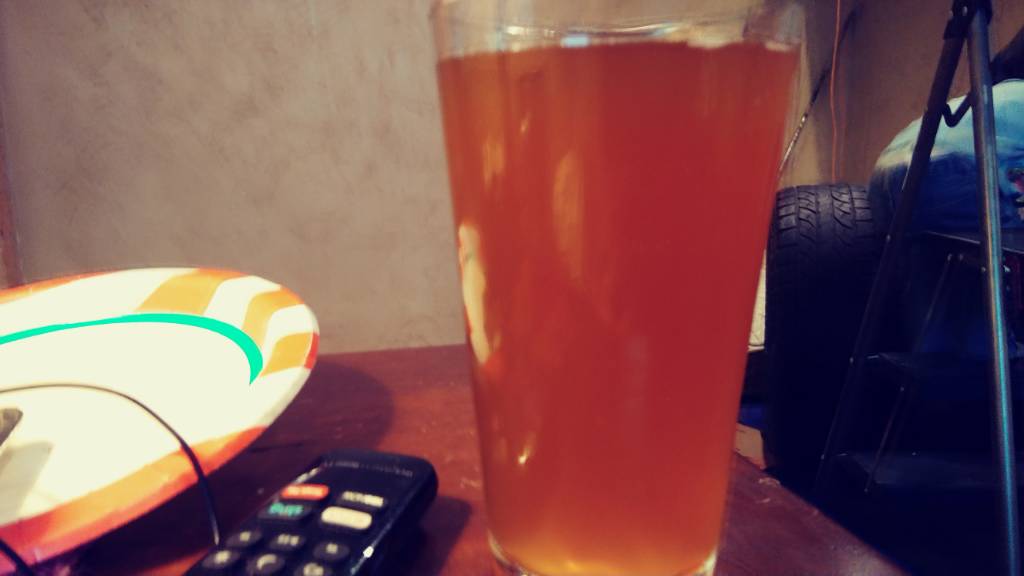Figured it was about time for another “update” post. Not that there are a lot of differences, but, there are some recurring questions and I have streamlined a few things. It is probably just as easy to update the original post with a link to what I have settled on over the last year as opposed to some of the same questions coming up on a regular basis.
**I brew 6.5 gallons of finished beer (post boil)..... this allows me to leave some hop/trub behind in boil kettle and fermenter and get 5 gallons eventually into serving keg. If you finish with 5 gallons post boil, you might want to adjust hops down a bit.
6.5 gallons post boil
5.75 gallons into fermenter
5 gallons into keg
GRAIN BILL:
I have settled in around 1.060 OG. I think this makes a perfect compromise between getting into DIPA range (having beers that are just too high in abv. for my preference) and going too far toward 1.050 where the beer may become too much of a session IPA for some peoples preferences.
*If you want a bigger IPA, I would just keep the ratios of grain and increase the amounts to hit a higher OG. I would leave the hops the same the first time as far as amounts, and then adjust if you feel you want more bitterness, dry hop etc. on subsequent batches.
Approximate percent of grain bill and the actual amt. I use for 6.5 gallons @ 84% mash efficiency (your efficiency may vary so use the percentages)
37.5% Rahr 2 Row (5 lbs)
37.5% Golden Promise (or similar like Pearl, Maris Otter) (5 lbs)
7.5% Flaked Oats (1 lb)
7.5% Flaked Barley 1 lb)
7.5 % Weyerman Wheat (1 lb)
2.5% Honey Malt (1/4 lb)
60 minute mash @152-155)
*Note on grain. Using all 2 Row for Base is probably fine. Using any combination of flaked Oats/Wheat/Barley to get into the 20% range is probably fine too. In fact, based on others input, and based on my own experience – I think you could do all kinds of things with the grain bill and be fine, including dropping a bunch of the flaked, using whatever you want for base malt etc. The two things I do think are good for this beer in regard to grain bill:
1.) Keep it light and simple….. 3-5 SRM. Not much in the way of caramel/crystal malts, etc.
2.) I do like the addition of small amount of Honey Malt and recommend keeping it.
HOPS: (I have gone to 1 whirlpool/flameout addition and 1 dry hop)
**
60 Min. = .5 oz Warrior (Or, none at all if you want to lay off bittering addition).
**Flameout/whirlpool =
Chill to 160 or below and add 6 ounces of Hops.
I generally go with 3 ounces of Citra, 2 ounces Mosaic, 1 ounce of Galaxy – but there are plenty of other combinations (listed later on).
I continue chilling at this point now…. No real “hop stand” at a particular temperature. I just like to get the temperature down to 160 or so, get the hops in, and continue chilling. It still takes 20-30 minutes from this point to going into fermenter anyway.
Stir up/whirlpool wort every 5 minutes or so to get hops in suspension.
Chill to 62-65 and let hops settle out as much as possible (just let it sit for 10minutes or so after it is chilled). Transfer wort to fermenter. I tend to leave behind .75 gallons of trub and hops (this is why I brew 6.5 gallon batch).
**Dry Hop – I now do a single, 6 ounce dry hop around day 2-3. Hops go in loose and they stay in for duration of fermentation.
My standard recipe dry hop is 3 ounces of citra, 2 ounces Mosaic, 1 ounce of Galaxy.
I no longer do multiple dry hops. I no longer use dry hop keg….. depending on your system, that might be something you still want to do. However, I have found no difference with a single flameout addition and a single dry hop – plus it is way easier.
WATER PROFILE: Use 100% RO water to start with and adjust to a specific profile.
There are multiple directions to go here. I have kind of settled in with a Sulfate:Chloride of around 120:120. Honestly, I think you could put either number between 75-150 and make a fine beer. It is likely just personal preference at some point if you are in those ranges. I think most people tend to go higher on the Chloride and lower on the sulfate.
100% RO water. I add per gallon of mash and sparge water -
Gypsum = .6 grams/gallon
CaCl = .7 grams/gallon
Epsom = .3 gram/gallon
Lactic Acid = .1ml/gallon
Lactic Acid = I add about .5ml- 1ml of lactic acid to the mash and the sparge. And may adjust a bit more…. Aiming for about 5.30-5.40 mash pH and Preboil kettle pH.
Using B'run Water
Ca = 105
Mg = 8
Na = 8
Sulfate = 120
Chloride = 122
Bicarbonate = 16
Mash pH = 5.35
Final runnings pH = 5.60
Pre-boil Kettle pH = 5.40-5.45
Post Boil pH = 5.3-5.35
**Water strategies to test out for yourself to see what you like best;
2:1 Sulfate:Chloride in the 150:75 range
1:1 Sulfate:Chloride with both in the 120-150 range
1:2 Sulfate:Chloride in the 75:150 range
All will produce a good beer, but you may find something you personally prefer.
I did go 200 sulfate:50 Cl and it was fine. But, it was not what I was looking for. It definitely “dried” the beer out a bit. I think it definitely moved this beer away from what most of us are shooting for in a “NE IPA.”
Water Profile - the simple solution:
***Many people ask about a more general guide to water because they do not know what their own water profile is, or they have not made the jump to using a water profile software. I use B'run water, and the above profile. However, if you just want to get in the ballpark of something "similar" to start with - The simplest solution is this:
100% RO water for both mash and sparge.
Per 5 gallons of mash water: 1 tsp of CaCl + 1/2 tsp Gypsum
Per 5 gallons of sparge water: 1 tsp of CaCl + 1/2 tsp Gypsum
This should bring you in around 140 Chloride and 80 Sulfate.
Or….. to try other versions….
*The opposite: 1tsp of gypsum and ½ tsp of CaCl per 5 gallon
*Equal ratios: ¾ - 1 tsp of each per 5 gallon.
This does not take into account trying to get Na or Mg numbers. It ignores bicarbonate and as it is 100% RO, it should bring your mash pH in around 5.41 without any acid addition.
If you are doing the generic additions above, you could use about ½-1 ml of lactic acid in 5 gallons of mash water and in 5 gallons of sparge water.
ROUGH estimate of grams to tsp of minerals:
1/4 tsp Gypsum = .9 grams
1/4 tsp CaCl = 1.1 grams
1/4 tsp Epsom Salt = 1.3 grams
1/4 tsp Canning Salt = 1.8 grams
FERMENTATION:
Yeast - Conan(vermont IPA) or 1318 are probably the two “go-to” yeasts for this.
*** I have also found that 1272 works great. I think there are many yeasts that would likely do just fine in beers like this. 1056, 1450, 007…. I would not be afraid to try other yeasts. People have played around with quite a few different yeasts, and I think people have been at least satisfied with almost any yeast they tried for the most part. But, I think 1318 and Conan are going to give you the most authentic NE IPA.
I tend to start fermentation off around 64 at let it free rise to 66-68 degrees through the first 3 days or so of fermentation. At that point, I like to move it somewhere that it can finish off in the 68-70-72 range.
OTHER THOUGHTS/NOTES:
I keep almost everything the same in brewing IPA's to this style. However, I do mix up the hops. I always bitter with warrior (Columbus on occasion), and always use 2 x 6 ounce additions – one at flameout/whirlpool and one for Dry Hop ....... but, not always the same hops. Some other options for hops that I have liked:
· Equal parts Citra/Mosaic/Galaxy
· Equal parts Citra/Mosaic or Citra/Galaxy
· 100% Citra
· 1-2 ounce Galaxy: 4-5 ounce Citra
· Centennial:Simcoe:Amarillo 1: 2.5: 2.5
· Sub in Simcoe for Galaxy
· Other hops that can be used with success: Vic Secret, Eureka, Azacca, Columbus, Amarillo, Simcoe, and others I am sure….. I find the fruity/tropical hops work better than some of the classic piney/west coast IPA hops.
At the end of the day I still find it very hard to beat Citra:Mosaic:Galaxy combos.
Some offshoots related to this beer:
Blonde Ale:
https://www.homebrewtalk.com/forum/threads/murican-blonde-ale.644482/
Besides just being a great blonde ale, I like using this beer to “make yeast”. When I get a pack of yeast, I brew this 4% blonde ale that uses modest kettle hops and no dry hops. When I keg it, I sanitize 4-6 mason jars in the ½ pint to pint size and lids. I leave a quart or two of beer in the fermenter, swirl it all up and then decant the slurry into mason jars….. basically, one pack of yeast turns into 6 jars of yeast to use on other beers. I might use 5 jars on this IPA or other beers, and then I use one of the jars on another blonde ale, and repeat harvesting yeast. I can easily get 15-20 beers out of a single pack of yeast doing this.
Hoppy Session Wheat: https://www.homebrewtalk.com/forum/threads/hoppy-session-wheat-beer.644047/
Want a great session beer (3.9-4.1 ABV range) that is hoppy, light and super drinkable….. basically a lighter version of the NE IPA above? Try this one. I was kind of looking for something else to do that was an off-shoot of this and was thinking maybe something in the realm of Gumballhead from Three Floyds…. This is what I came up with and it is really good. A lot of my regulars actually like this beer more than the NE IPA above.








![Craft A Brew - Safale BE-256 Yeast - Fermentis - Belgian Ale Dry Yeast - For Belgian & Strong Ales - Ingredients for Home Brewing - Beer Making Supplies - [3 Pack]](https://m.media-amazon.com/images/I/51bcKEwQmWL._SL500_.jpg)




















































